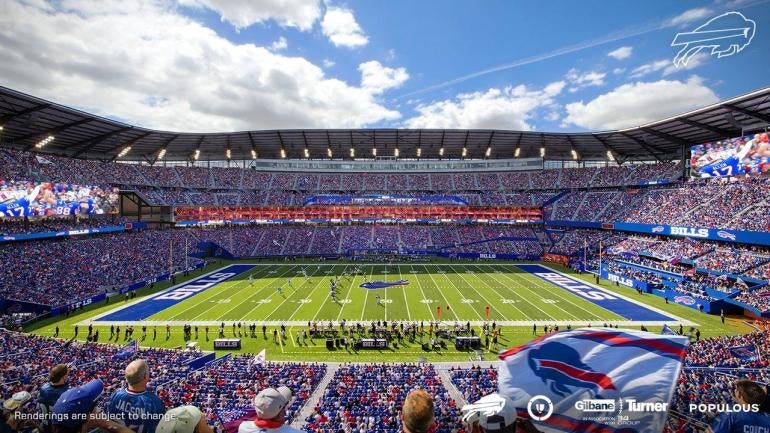
The Buffalo Bills are set to break ground on a new stadium that they hope will be ready in time for the 2026 season. Following the Erie County Legislature's approval of their stadium agreement, the Bills announced on Thursday that they will immediately begin the process of building their new home, which will be located across the street from where the Bills currently play in Orchard Park, New York.
According to the franchise, the Bills' "start-of-the-art, pen-air stadium" will be built on a 242-acre site and will cover about 1.35 million square feet, making it the biggest project ever built in Western New York. The site's related development also includes the construction of a 75,000-square-foot ancillary building and demolition of the current stadium.
"We want to thank Governor Hochul, the County Executive and all of our public partners for bringing this process to a successful conclusion," said Bills executive vice president & COO, Ron Raccuia. "All of the legal agreements and public-private partnerships with the county and the state are signed. There are no more documents. All the focus is now on construction and the opening of the stadium, which will start immediately."
The Bills' official website describes the new stadium: "The Bills, in conjunction with Legends and stadium architectural firm Populous, have left no stone unturned in covering every innovative element of new stadium design. The exterior stadium image highlights the team's desire for a visual identity that reflects some of the historical architecture of Buffalo, while also delivering a modern appearance."
The Bills have released renderings of the new stadium in Twitter posts, giving a first look at what the project will look like.
One step closer toward the New Bills Stadium.
— Buffalo Bills (@BuffaloBills) March 27, 2023
The latest renderings have arrived! #BillsMafia
Be the first to learn more: https://t.co/wQjumbzQA7 pic.twitter.com/vdyKBji4bt
The NFL and the Bills agreed to contribute $500 million and Buffalo owners Terry and Kim Pegula will be committing $350 million. The Bills will be financially responsible for any construction that goes over $1.4 billion.
The state will give $600 million for construction costs and $280 million for maintenance and operational costs during the three-decade long deal. The state and county originally shared control of the stadium, but the agreement has the state taking sole control.
The agreement includes a 30-year lease with a non-relocation clause. The Bills would have to return all public funding in the first 14 years of the deal, with the pay-back amount diminishing in the last 16 years of the agreement. It extends the lease of the current stadium until July 31, 2028.
The agreement includes the Bills committing to giving back to the community, with a yearly $3 million contribution towards social, education and the economic health of the local area.
The current Bills stadium opened in 1973. It was decided that a new stadium made more sense financially than renovating what is there now.






















